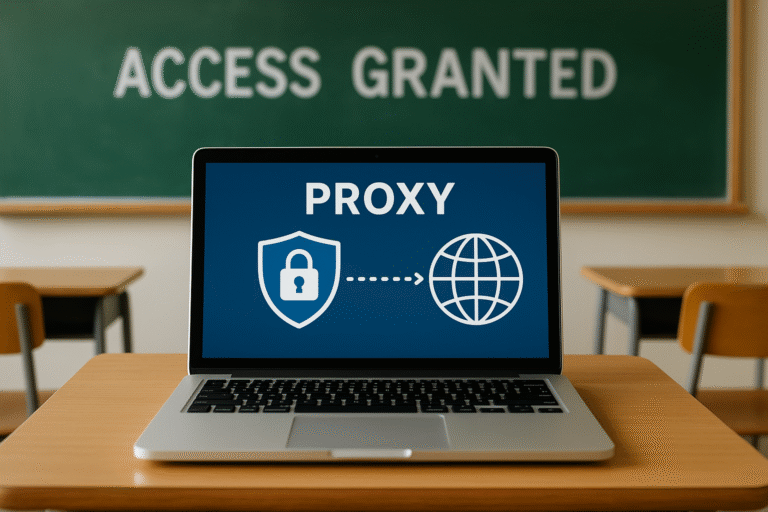Introduction
Ever felt the frustration of hitting a “This Site is Blocked” wall when trying to access a harmless educational resource or watch a video for a class project? If so, you’re not alone. In the ever-evolving world of internet restrictions, students have turned to something called proxies for school. But what are they exactly? Are they safe? And most importantly—are they worth the risk?
In this article, we’ll explore proxies from every angle, unpack their benefits and drawbacks, and help you figure out if there are better alternatives for your browsing woes.
What Are Proxies for School?
At their core, proxies for school act like middlemen between you and the internet. Instead of your device directly connecting to a website, the proxy server does it for you and sends the data back—almost like a digital disguise.
Think of it this way:
-
Without a proxy: You walk into a store wearing your school uniform—everyone knows where you came from.
-
With a proxy: You wear a costume, and suddenly, nobody can trace you back to your school.
Why Do Schools Block Websites Anyway?
Before diving deeper into proxies, let’s ask the obvious question: Why do schools block websites in the first place?
Here are a few key reasons:
-
Preventing distractions – Schools want students focused on learning, not binge-watching videos.
-
Ensuring network security – Limiting access helps keep malicious sites from spreading viruses.
-
Compliance with policies – Many educational institutions must follow internet safety laws for minors.
But sometimes, the block list feels a bit over-the-top. Need a YouTube tutorial for science class? Boom—blocked. Want to research social trends? Sorry, social media’s off-limits. That’s when proxies start to look tempting.
How Do Proxies for School Work?
Proxies redirect your internet traffic through another server, hiding your school’s IP address. Here’s a quick breakdown:
-
You type a website URL into your browser.
-
Proxy server fetches the website for you.
-
Website only sees the proxy server’s information, not your school’s network.
Some proxies are web-based (just visit the proxy site and browse), while others require software installation or browser extensions.
Types of Proxies Students Often Use
Not all proxies are created equal. Here’s the lowdown on the different kinds:
1. HTTP Proxies
-
Best for general web browsing.
-
Easy to set up but not super secure.
2. SOCKS Proxies
-
Work with various types of traffic, including gaming or streaming.
-
Slower than HTTP but more versatile.
3. VPNs (Virtual Private Networks)
-
Technically not proxies, but they serve a similar purpose—encrypting your entire internet connection.
-
Usually more secure but may require a subscription.
4. Public Web Proxies
-
Free, easy to find, but often slow and risky due to unknown ownership.
Pros of Using Proxies for School
Why are so many students talking about proxies? Because they offer a few tempting perks:
-
Access to blocked sites – Research resources, educational videos, or reference materials become reachable.
-
Anonymity – Proxies can mask browsing activity from school filters.
-
Learning about tech – Using proxies can teach students about networking and cybersecurity (ironically).
Cons (and Risks) of Using Proxies at School
Before you dive headfirst into proxy territory, you’ve gotta know the risks:
-
Data theft – Some proxies are traps designed to steal passwords or personal info.
-
Sluggish speed – Free proxies often slow your connection to a crawl.
-
Violation of school rules – Using proxies might result in detention—or worse, a suspension.
-
Security threats – Malware-laden proxies can compromise school networks and devices.
Are Proxies for School Worth It?
That’s the million-dollar question, right? Sure, proxies can grant access to a blocked site, but the risks may outweigh the rewards. Imagine trying to bypass a school’s firewall only to have your login credentials stolen—or worse, trigger a network alert.
Safer Alternatives to Proxies
Before you risk a proxy, consider these safer options:
-
Request website access – Sometimes, all it takes is asking your teacher or IT department to whitelist a site.
-
Use educational versions – Platforms like YouTube have YouTube EDU, designed for schools.
-
Offline resources – Download materials at home and bring them to school.
-
Mobile hotspot – Use personal data (if allowed) rather than school Wi-Fi.
FAQs About Proxies for School
1. Are proxies illegal to use at school?
Not necessarily, but bypassing school filters might violate school policy, leading to disciplinary action.
2. Can proxies keep my browsing totally anonymous?
Not always. Many free proxies log your activity, which can be sold or misused.
3. Are VPNs better than proxies for school use?
VPNs are generally more secure but often cost money and may still be against school rules.
Conclusion
Proxies for school may seem like a golden ticket to unrestricted browsing, but they’re not without risks—security concerns, slow speeds, and potential disciplinary consequences. Instead of sneaking past digital hall monitors, consider safer, rule-abiding alternatives. But if curiosity (or necessity) leads you to explore proxies, make sure you understand exactly what you’re getting into. After all, in the digital world, knowledge isn’t just power—it’s protection.

